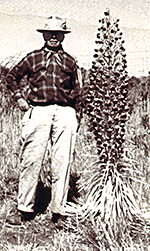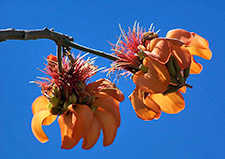Wildflowers Grow In Profusion on Maui
Many Brilliant Varieties are Found on Island
By DAVID FLEMING
(From a 1935 special edition of The Maui News celebrating
the opening of the road to Haleakala Crater )
|
Wiliwili: An ugly tree growing in dry and hot localities somewhat umbrella shaped, destitute of leaves for most of the year. Following the first winter rains, the bud breaks into beautiful red blossom before a single leaf has appeared. The seeds are a brilliant scarlet, about the size of a garden bean; the wood is light as cork and was used for outriggers of canoes and for net floats.
|
|
Hinahina: The “Silversword.” Driven back by the ravages of cattle and goats, this plant may rarely be found except in the more inaccessible portions of the Crater of Haleakala. No one can describe the beauty of a full grown Silversword plant with its stem studded with drooping yellow blossoms-it must be seen to be appreciated. Several varieties of this plant are found on Maui ranging from the true Silversword of Haleakala with its glistening coat of silver, down through the Wilkesias to the dwarf species found of Kukui. The Haleakala has recently been introduced on Kukui but does not appreciate the excessive rainfall in that location. The Wilkesia Grayana with its mass yellow blossoms is also a credit of this family.
|
 |
A trained botanist could, no doubt, after some study and more climbing enumerated many more indigenous flowering plants; but this brief article is neither made by a trained botanist nor for use by a trained botanist. It is merely a nature lover’s account of a small part of the beautiful world standing at our door, waiting to be appreciated if we will only give it the time it so richly deserves.

